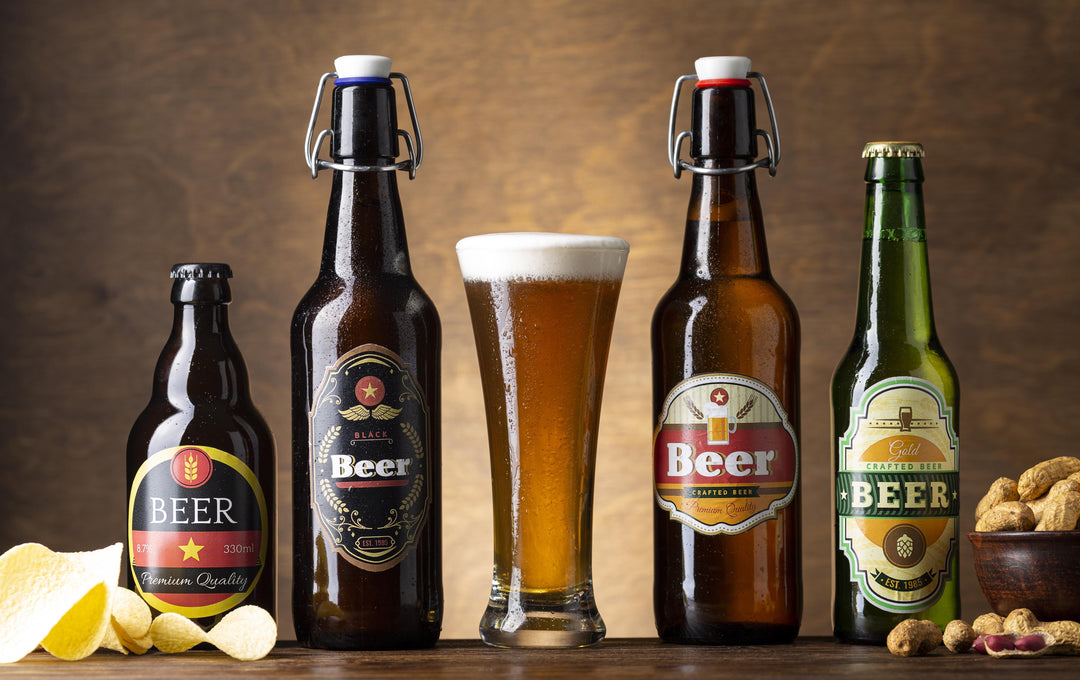
Going Beyond Cocktails: Beer for Your Home Bar
Posted on
When it comes to creating a well-stocked home bar, cocktails often take center stage. However, another beloved libation deserves a place of honor on your shelves - beer. Beyond being a refreshing beverage, beer offers various flavors, styles, and brewing traditions that can elevate your home bar experience to new heights.
From crisp lagers to complex ales and everything in between, exploring the world of beer opens up a whole new realm of possibilities for the aspiring home bartender. So, let's dive into beer and discover how it enhances your home bar and delights your taste buds with some recipes ahead!

The Brewed History
Isn't it fascinating to think about the processes of producing a delicious beer? The secret behind this beloved and refreshing drink lies in just four simple ingredients: barley, water, hops, and yeast. It's incredible how these natural elements come together to craft the perfect beer for us to enjoy and savor.
Beer, amongst the oldest drinks, emerged thousands of years ago alongside the cultivation of cereals. A lucky revelation transpired when these grains, once soaked, underwent fermentation, turning the water into a delightful beverage – marking the birth of beer.

The first Barley Beer was known to have originated in the Middle East 5,000 years ago by the Sumerians of Ancient Mesopotamia. The uncertain quality of water led to the popularity of alcoholic drinks since water in the early days was unfiltered, and the likelihood of contracting diseases like cholera was very high. Beer consumption flourished during the Babylonian Empire when an ancient decree called the “Code of Hammurabi” allowed the distribution of beer rations to citizens.
Brewing techniques have stemmed in the Middle East before spreading to Europe. 1420, Germany introduced bottom fermentation, where yeast sank to the vessel's bottom. In the early days, yeast would rise, often overflowing or requiring manual skimming during fermentation.

The Art of Brewing: Crafting the Liquid Gold
Malting
Grains are soaked in water for about two days or until the grains look ready for germination. It is essential for generating the enzymes needed to transform starches into sugars, which is critical for fermentation. Without malting, the beer lacks adequate sugar for fermentation.
Mashing
The malted grains are then transferred to a “Mash tun,” where the grist is incorporated with warm water, called liquor, and heated to temperatures ranging from 100 to 170 degrees Fahrenheit. This method activates malt enzymes that break down starches into sugars, which is essential for alcohol production. This conversion normally occurs within one to two hours.

Lautering
Lautering involves isolating the wort from the grains in a separate “lauter tun,” where the mash settle creates a natural filter at the bottom for the wort. The first step to lautering is Mashout, which involves heating the mash to 170°F, stopping enzymatic activity, keeping fermentable sugars, and enhancing wort fluidity for more manageable handling.
Next, the wort is emptied from the base of the lauter tun and recirculated, naturally filtering out loose grain particles through the grain bed to achieve a clearer wort. Lastly, the spent grain is rinsed with hot water to extract as much sugar as possible from the remaining wort. This final lautering process is called sparging.
Boiling
The wort is transferred to a copper pot, where it undergoes boiling. This process causes water to evaporate, raising the sugar concentration and sterilizing the mixture for fermentation. This process typically lasts from 60 to 120 minutes, and then hops are added gradually to extract its flavor, giving the mixture a bitter taste to balance out the sugar.

Hops
It’s a dried female flower of a Humulus lupulus plant that’s added gradually or at an interval during boiling. It can be added at the inception of the boil for advanced bitterness, with longer boiling times yielding more bitterness. Alternatively, they can be added halfway through for flavor or near the end for both flavoring and aroma. It provides the fragrance, bitterness, and foaming attributes of a beer.
Fermenting
After boiling and the mixture has cooled, yeast is then added to the mixture to develop the alcohol and carbon dioxide. The second phase of fermentation allows the beer's flavors to fully develop; increased fermentation temperatures produce advanced esters, improving aroma complexity. Fermentation normally occurs between 3-14°C, completing within a span of 14 days.

Aging, Maturation, and Carbonation
After fermentation, the Green beer is refrigerated in a vat at 0°C for weeks to months, causing protein, yeast, resin, and other undesirable substances to precipitate out, resulting in a clearer beer. Then, after aging, the beer is carbonated and then clarified, filtered, bottled, barreled, or canned to enjoy!

Discovering beer and its wide range of flavors, styles, and brewing techniques is truly a wonder. Whether you prefer a crisp and refreshing lager, a hoppy and aromatic IPA, or a rich and complex stout, there is a beer to suit every taste and occasion.
Remember to consider the diverse and exciting world of beer. It offers a new dimension of flavors and experiences that can take your home bartending skills to the next level.
Cheers to expanding your horizons and embracing the wonderful world of beer!
POLICIES & WARRANTY
ONLINE CONTACT
Email:
support@barebarrel.com
Facebook Messenger:
m.me/bare.barrel.mixology
CELLULAR CONTACT
SMS Text Message:
+1 (845) 498-1395
(cannot accept phone calls)


Leave a comment: